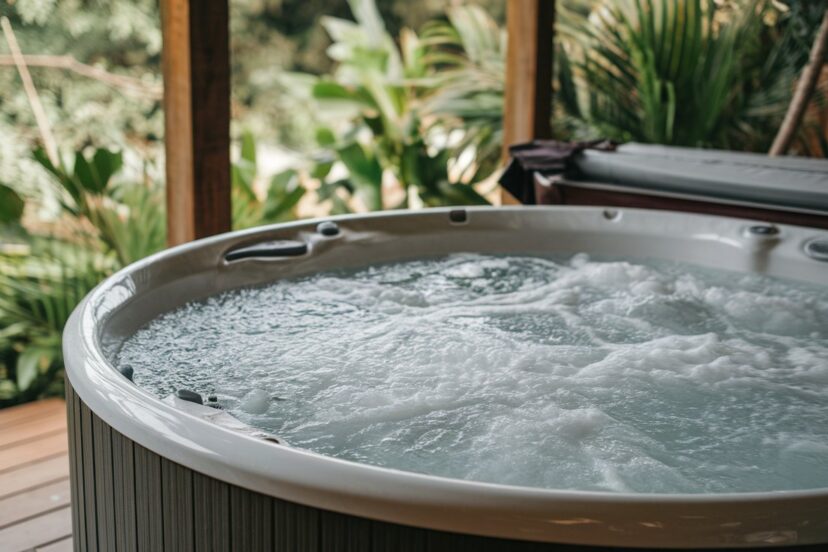Clearing Cloudy Hot Tub Water
*We may earn a commission for purchases made using our links. Please see our disclosure to learn more.
Every hot tub owner has experienced that moment of disappointment, pulling back the cover to find murky, uninviting water instead of the crystal-clear oasis they were anticipating. Cloudy hot tub water is not just unattractive; it can indicate chemical imbalances, contamination, or filtration issues that might affect both your equipment and your health. The good news is that with proper diagnosis and treatment, you can transform your cloudy spa back to pristine condition and implement practices to prevent future problems. This comprehensive guide will equip you with the knowledge and techniques to maintain sparkling clear water year-round.
Key Takeaways:
- Cloudy water typically results from pH imbalance, sanitizer issues, biofilm buildup, or filter problems
- Regular testing and maintenance prevents most cloudy water issues
- Shocking your hot tub is often the first step in clearing cloudy water
- Proper filtration is essential for maintaining water clarity
- Prevention through routine care is easier than treating cloudy water
“The quality of your hot tub water directly affects your soaking experience. Clear water isn’t just about aesthetics, it’s about creating a safe, healthy environment for relaxation and wellness.”
— Dr. Roy Vore, Recreational Water Illness Prevention Specialist and author of “Hot Tub Science”
Recommended Products for Clearing Cloudy Hot Tub Water
1. SpaGuard Enhanced Shock
SpaGuard Enhanced Spa Shock is the ultimate solution for maintaining clean, clear, and inviting spa water. This versatile powder works as a shock, clarifier, flocculent, and pH buffer, all in one product. Designed to restore the sparkle to your spa water while eliminating unpleasant odors, it ensures a pleasant and comfortable soak every time. Compatible with both chlorinated and brominated spas, as well as those using ozone or ionization systems, SpaGuard Enhanced Spa Shock makes spa maintenance simple and effective.
- Multi-functional: Works as a shock, clarifier, flocculent, and pH buffer.
- Water clarity: Restores sparkle and removes unpleasant odors.
- Versatile compatibility: Works with chlorinated, brominated, ozone, and ionization systems.
- May require regular use: To maintain optimal results, frequent application may be needed.
- Powder form: Can be tricky to handle without proper storage.
- Price: Higher price compared to basic shock products.
This powerful oxidizing treatment quickly breaks down organic contaminants that cause cloudy water. It’s non-chlorine based, making it gentle on hot tub surfaces while effectively eliminating bacteria and body oils. A weekly treatment helps maintain water clarity and extends the life of your spa water. Many users report seeing improvement within hours of application, especially when combined with proper filtration.
2. Leisure Time Enzyme Plus
Leisure Time SGQ-02BX Enzyme Liquid is the perfect solution for keeping your spa water clean and clear. This enzyme-based liquid effectively removes oils, lotions, and organic contaminants from the water line, reducing the need for frequent sanitizer use. Ideal for maintaining your spa water in pristine condition, it works with chlorine, bromine, ozone, and biguanide sanitizers. Simply add weekly as part of the Leisure Time Simple Spa Care program for effortless maintenance and a more relaxing spa experience.
- Effective cleaning: Removes oils, lotions, and organic buildup from the water line.
- Sanitizer efficiency: Reduces the need for additional sanitizer use, extending your spa's lifespan.
- Compatible: Works with various sanitizing systems including chlorine, bromine, and ozone.
- Weekly application required: Must be used regularly for best results.
- Short wait time: Requires a 15-minute wait before using the hot tub after treatment.
- Price: Slightly higher than basic cleaning products.
This specialized enzyme treatment targets oils, lotions, and organic matter that standard sanitizers might miss. Regular use prevents scum lines and cloudy water by breaking down these substances before they can accumulate. It’s compatible with all sanitizing systems and helps reduce chemical usage. The natural enzyme formula works continuously between applications to digest oils and organic waste, creating a cleaner water environment overall.
3. Pleatco Advanced Hot Tub Filter Cleaner
Keep your hot tub filters in top condition with SPA Filter WASH by Pleatco. These powerful cleaning tablets are designed to clean hot tub filter cartridges, removing dirt, oils, and debris, ensuring your spa runs smoothly. The tablets are easy to use, providing a quick and effective way to maintain your filters. With three tablets per pack, this product helps extend the life of your filter, promoting better water quality and reducing maintenance costs.
- Effective cleaning: Removes dirt, oils, and debris from hot tub filters.
- Easy to use: Simply drop the tablet in for a hassle-free cleaning experience.
- Longer filter life: Helps maintain filter performance and extend its lifespan.
- Requires soaking time: The cleaning process can take several hours.
- Limited quantity: Only three tablets per pack may not be enough for long-term use.
- Price: More expensive compared to traditional filter cleaning methods.
Clean filters are essential for clear water, and this professional-strength cleaner dissolves oils, minerals, and debris that collect in filter pleats. The concentrated formula restores filter efficiency and extends filter life. Regular filter cleaning with this product significantly improves water clarity. Unlike simple rinses with a garden hose, this chemical cleaner penetrates deep into filter media to remove embedded contaminants that restrict water flow and reduce filtration effectiveness.
4. Hot Tub Things Spa Water Clarifier
Achieve crystal-clear water in your hot tub with Hot Tub Things Spa Clarifier. This advanced formula effectively eliminates cloudiness and impurities, enhancing water clarity and creating a more enjoyable soaking experience. Designed to improve filtration efficiency, it helps trap even the smallest particles and prevents them from re-entering the water. Ideal for frequent use, this professional-grade clarifier ensures your spa remains sparkling clean with minimal maintenance.
- Fast-acting formula: Quickly eliminates cloudiness for clear water.
- Enhanced water clarity: Improves overall clarity, making your spa more inviting.
- Boosts filtration efficiency: Traps small particles for prolonged water cleanliness.
- Requires regular use: Consistent application needed to maintain clarity.
- Might need additional treatment: In cases of heavy contamination, may require multiple uses.
- Price: Slightly higher than basic clarifiers on the market.
This fast-acting clarifier coagulates tiny particles that cause cloudiness, allowing them to be captured by your filter. It works with all sanitizing systems and helps restore crystal clear water within 24 hours. It’s also effective at preventing cloudiness when used as part of regular maintenance. The polymer-based formula binds microscopic particles together, creating larger clusters that your filtration system can easily remove.
Understanding Cloudy Hot Tub Water
Before jumping into treatment, it’s important to understand what causes cloudy water in the first place. Identifying the specific issue will help you apply the most effective solution and prevent recurrence.
Common Causes of Cloudy Hot Tub Water
pH Imbalance
When your hot tub’s pH levels drift too high or too low, chemicals can’t work efficiently. High pH often leads to scale formation and cloudiness, while low pH can cause corrosion and irritation. The ideal pH range for hot tubs is 7.2-7.8. When pH rises above 7.8, calcium and other minerals can precipitate out of solution, creating a cloudy appearance and potentially damaging heating elements.
Inadequate Sanitizer Levels
Chlorine or bromine levels that are too low allow bacteria and organic material to accumulate, resulting in cloudy water. On the flip side, extremely high sanitizer levels can also cause cloudiness and chemical odors. Proper sanitizer levels (3-5 ppm for chlorine, 4-6 ppm for bromine) keep bacteria in check while maintaining water clarity.
Biofilm Development
Biofilm is a slippery bacterial colony that forms on hot tub surfaces and plumbing. As it sloughs off, it can cloud your water and protect bacteria from sanitizers. Biofilm is particularly common in hot tubs that aren’t regularly shocked or drained. These microscopic bacterial communities create a protective matrix that standard sanitizers struggle to penetrate, making them particularly troublesome once established.
Clogged or Dirty Filters
Your hot tub filter is the primary defense against particles that cause cloudiness. When filters become clogged or dirty, they can’t efficiently remove contaminants, leading to cloudy water. Even filters that appear clean on the surface may have restricted water flow due to embedded oils and minerals, reducing their effectiveness dramatically.
Total Dissolved Solids (TDS)
Over time, your hot tub water accumulates dissolved chemicals, minerals, and organic matter. When TDS levels get too high, water becomes increasingly difficult to balance and maintain clarity. This is often described as “tired water” that resists treatment and requires replacement regardless of chemical additions.
Hard Water Minerals
Calcium and magnesium can precipitate out of solution, especially in hard water areas, creating cloudiness and scale on surfaces. These minerals become less soluble at higher temperatures and pH levels, making hot tubs particularly susceptible to scaling issues. Areas with water hardness above 250 ppm may require special consideration during initial filling and ongoing maintenance.
Body Oils and Cosmetics
Lotions, deodorants, makeup, and natural body oils enter the water with each use. Without proper chemical treatment, these can accumulate and cause cloudiness. These substances can combine with minerals in the water to form a sticky residue that coats plumbing and equipment, further complicating water clarity issues.
Algae Growth
While less common in properly sanitized hot tubs, certain algae species can develop resistance to standard sanitizers, especially if levels are inconsistent. Early-stage algae growth can cause cloudiness before visible blooms appear, particularly in tubs exposed to sunlight.
Step-by-Step Solutions for Clearing Cloudy Water
Step 1: Test Your Water Chemistry
Before adding any treatments, test your water to identify any chemical imbalances. A reliable test kit should measure:
- pH (7.2-7.8)
- Total alkalinity (80-120 ppm)
- Calcium hardness (150-250 ppm)
- Sanitizer levels (3-5 ppm for chlorine, 4-6 ppm for bromine)
Adjust any parameters that fall outside these ranges. Often, simply correcting the chemistry will resolve cloudiness within 24 hours. Digital testers provide more accurate readings than test strips, especially for critical parameters like pH and sanitizer levels. For the most accurate results, take water samples from elbow depth, away from return jets.
When adjusting chemistry, always correct alkalinity first, then pH, and finally sanitizer levels. This sequence provides the most stable results and prevents unnecessary fluctuations. Allow at least one hour of circulation between chemical adjustments to ensure accurate readings and prevent chemical interactions.
Step 2: Clean or Replace Your Filter
A dirty filter is frequently the culprit behind cloudy water. Remove your filter and inspect it for debris, oils, and scale buildup. Deep clean it by soaking in a specialized filter cleaner like the Pleatco Advanced Cleaner mentioned above. For filters older than 12-18 months, consider replacement as the material breaks down over time.
For best results:
- Rinse filters weekly with a garden hose
- Deep clean filters monthly
- Replace filters every 12-18 months
When cleaning filters, pay special attention to the pleats, where debris often becomes trapped. Gently separate each pleat and rinse from top to bottom to dislodge particles. After chemical cleaning, rinse thoroughly to remove all cleaner residue, which could cause foaming if returned to the hot tub while still present on the filter.
Consider keeping a spare filter on hand so you can install a clean one immediately while deep cleaning the other. This approach ensures continuous filtration and minimizes downtime, especially important when addressing cloudy water issues.
Step 3: Shock Your Hot Tub
Shocking your hot tub oxidizes organic matter and kills bacteria that may be causing cloudiness. For best results:
- Ensure proper pH before shocking (7.2-7.6)
- Add shock at dusk or night to prevent UV degradation
- Keep the cover off for 20-30 minutes after shocking
- Run jets on high to circulate the shock treatment
- Wait 24 hours before retesting water
The amount of shock needed depends on your specific situation. For routine maintenance, follow package directions for normal dosing. For treating cloudiness, consider using an increased dose (often called a “double shock”) to rapidly oxidize accumulated contaminants. Always follow product guidelines for maximum dosage limits.
Non-chlorine shock (MPS) works quickly and allows hot tub use within hours, while chlorine or bromine shock provides longer-lasting sanitizing effects but requires longer waiting periods before use. For persistent cloudy water problems, alternating between the two types of shock treatments can provide more comprehensive results.
Step 4: Add a Water Clarifier
If cloudiness persists after shocking, a water clarifier can help. Clarifiers work by combining tiny particles into larger ones that your filter can capture. Apply as directed and run your filtration system continuously for 24 hours.
Water clarifiers come in various formulations with different active ingredients. Polymer-based clarifiers are most common for hot tubs and work by creating an electrostatic charge that attracts tiny particles together. For best results, ensure your filter is clean before adding clarifier, as the increased particle load will quickly clog a dirty filter.
Some clarifiers also contain flocculants that cause particles to sink to the bottom rather than be captured by the filter. If using this type, you may need to vacuum the hot tub floor after treatment to remove the settled material. This approach is particularly effective for very fine particles that might otherwise pass through standard filtration.
Step 5: Consider an Enzyme Treatment
Enzyme treatments specifically target oils and organic materials that cause cloudiness and scum lines. Unlike clarifiers that clump particles, enzymes actually break down organic matter. Regular use prevents buildup before it becomes problematic.
Enzymes work continuously but relatively slowly, making them excellent preventive treatments rather than quick fixes. Adding weekly enzyme treatments to your maintenance routine can significantly reduce the frequency of cloudy water episodes, especially in frequently used hot tubs.
Most enzyme products are compatible with all sanitizing systems, but always verify compatibility with your specific sanitizer. Some enzyme formulations are tailored to specific contaminants—for example, targeting bodily oils versus environmental organic matter—so select products appropriate for your typical usage patterns.
Step 6: Address Biofilm if Present
If your hot tub has been operating for months without a deep clean, biofilm may be contributing to cloudiness issues. Specialized biofilm remover products penetrate and break down these bacterial colonies in plumbing lines and equipment—areas that routine shock treatments might not reach effectively.
For best results:
- Add biofilm remover to water and circulate through all jets
- Run all jets in sequence to ensure treatment reaches all plumbing
- Follow with a shock treatment to eliminate released contaminants
- Clean or replace filters after treatment to remove dislodged material
Biofilm treatments should be performed before draining the hot tub, as they release significant contaminants into the water. This approach ensures that displaced biofilm is removed with the old water rather than remaining in the system.
Step 7: Drain and Refill if Necessary
If your water remains cloudy despite these treatments, it may be time for a fresh start. Hot tub water should typically be changed every 3-4 months, but high usage or persistent clarity issues might necessitate more frequent changes.
When draining:
- Use a line flush product to clean plumbing before emptying
- Clean all surfaces while the tub is empty
- Clean or replace the filter
- Refill with fresh water
- Balance chemicals properly before heating
Consider using a hose filter when refilling, especially if your source water contains high levels of metals or minerals. These filters attach directly to your garden hose and remove contaminants before they enter your hot tub, providing a cleaner starting point for your water care.
After refilling, add chemicals individually with at least 30 minutes of circulation between additions. This sequential approach prevents unwanted chemical interactions and provides more stable initial water chemistry.
Prevention: The Best Solution for Cloudy Water
Preventing cloudy water is far easier than treating it. Implement these practices to maintain crystal clear water:
Regular Testing and Chemical Balancing
Test your hot tub water 2-3 times weekly and after heavy use. Adjust chemicals promptly when readings fall outside recommended ranges. Small, frequent adjustments are better than large corrections.
Consider keeping a detailed log of your water chemistry readings and treatments. This record allows you to identify patterns and anticipate needs before problems develop. Many digital testing systems include apps that automatically track history and provide recommendations based on trends.
For the most accurate results, calibrate test equipment regularly according to manufacturer guidelines. Even digital testers can drift over time, leading to incorrect readings and inappropriate chemical adjustments.
Establish a Consistent Shock Schedule
Shock your hot tub weekly, regardless of appearance or usage. This preventive measure oxidizes contaminants before they can accumulate and cause problems.
Consider alternating between different types of shock treatments for more comprehensive results. For example, use non-chlorine shock for routine maintenance and chlorine-based shock monthly for deeper cleaning. This approach addresses a broader spectrum of contaminants than using a single product exclusively.
Practice Good Hot Tub Hygiene
- Shower before entering to remove lotions, oils, and cosmetics
- Keep the cover clean and properly secured when not in use
- Rinse bathing suits with fresh water rather than detergent before use
- Avoid eating or drinking in the hot tub
- Keep pets out of the water
- Limit sessions to reasonable lengths (under 30 minutes) to reduce body oil accumulation
- Use disposable spa wipes to quickly clean the waterline after each use
Maintain Your Filtration System
- Run circulation pumps at least 8 hours daily
- Clean filters regularly according to manufacturer recommendations
- Replace filters on schedule, even if they appear clean
- Consider upgrading to higher-quality filters if cloudiness is a recurring issue
- Verify proper water flow through filters and adjust if restricted
Use Preventive Treatments
- Enzyme treatments break down oils before they accumulate
- Mineral sanitizers reduce chemical needs and prevent bacteria growth
- Water clarifiers can be used preventively in small doses
- Scale inhibitors protect against mineral buildup in hard water areas
- Regularly inspect and clean jets and intake grates to ensure proper circulation
Troubleshooting Persistent Cloudiness
If you’ve followed all the steps above and still have cloudy water, consider these less common causes:
- Air in the System: Air bubbles from a leak in the plumbing can create a cloudy appearance. Check for leaks and properly bleed air from the system. Pay particular attention to pump unions and heater connections, as these are common sites for air infiltration.
- Microparticles: Some contaminants are too small for standard filtration. In this case, a specialized filter aid or flocculant may help by binding these tiny particles together. Consider temporarily adding a small mesh filter sock to your system to capture these elusive particles.
- Chemical Interactions: Some chemicals can react with each other or with contaminants in the water. If cloudiness appears immediately after adding chemicals, this may be the cause. Wait 24 hours to see if it clears. Always add chemicals separately with adequate circulation time between additions to prevent unwanted reactions.
- Water Source Issues: If your source water contains high levels of metals or minerals, these can cause persistent cloudiness. Consider using a pre-filter when filling your hot tub or adding a metal sequestrant. Water softeners can help with hard water, but they replace calcium with sodium, which brings its own set of challenges for hot tub maintenance.
- Equipment Problems: Inadequate circulation due to pump problems, blocked jets, or improperly set valves can contribute to cloudiness. Verify that all equipment is operating properly and that water is flowing freely through all systems.
Conclusion
Cloudy hot tub water is frustrating but fixable with the right approach. By understanding the root causes, implementing effective solutions, and maintaining good preventive practices, you can enjoy crystal clear water with minimal effort. Remember that consistency is key—regular maintenance prevents most issues before they start.
The products recommended in this guide—SpaGuard Enhanced Shock, Leisure Time Enzyme Plus, Pleatco Advanced Filter Cleaner, and Hot Tub Things Water Clarifier—form a comprehensive treatment system that addresses the most common causes of cloudy water. Using them as directed, along with proper testing and maintenance, will help ensure your hot tub remains a clean, inviting oasis for relaxation.
With diligent care and the knowledge gained from this guide, you’ll be able to quickly diagnose and treat water clarity issues when they arise. More importantly, you’ll develop preventive habits that minimize their occurrence, allowing you to focus less on maintenance and more on enjoying the therapeutic benefits your hot tub was designed to provide.
Frequently Asked Questions
Q: How quickly should my cloudy hot tub clear up after treatment?
A: Minor cloudiness typically clears within 24 hours after proper chemical balancing and shocking. More severe cases may take 2-3 days of continuous filtration and treatment. If cloudiness persists beyond 3 days despite proper treatment, you may need to drain and refill.
Q: Can I use my hot tub when the water is cloudy?
A: It’s not recommended to use a hot tub with cloudy water. Cloudiness often indicates chemical imbalance, inadequate sanitization, or contaminant buildup—all of which could cause skin irritation or potential health issues. Clear the water before resuming use.
Q: How often should I change my hot tub water to prevent cloudiness?
A: Most manufacturers recommend changing hot tub water every 3-4 months. However, this varies based on usage, maintenance, and water quality. A good rule of thumb is to drain and refill when the total dissolved solids (TDS) level exceeds 1,500 ppm above your starting water’s TDS.
Q: Will running my jets help clear cloudy water?
A: Yes, running your jets helps circulate water through the filtration system, which can speed up clearing. However, if cloudiness is caused by chemical imbalance or dirty filters, circulation alone won’t solve the problem. Use jets in combination with proper treatment.
Q: Can shocking my hot tub cause cloudiness?
A: Temporarily, yes. Shock treatments oxidize contaminants, breaking them down into particles that can cause short-term cloudiness. This should clear within 24 hours as the filter removes these particles. If cloudiness persists beyond 24 hours after shocking, other issues may be present.













